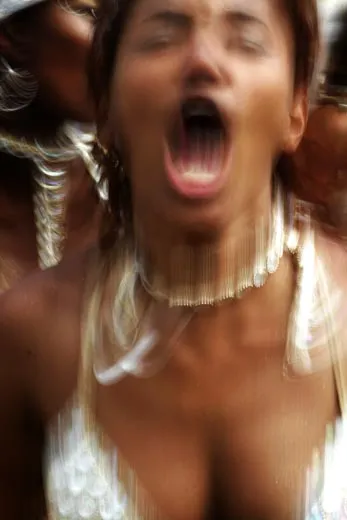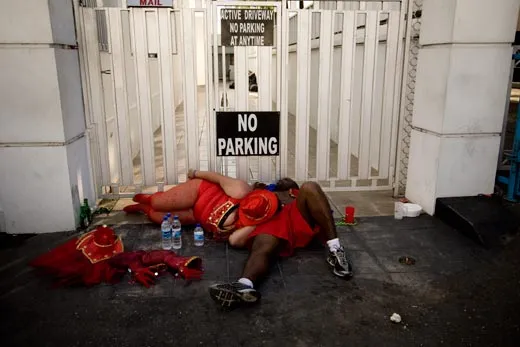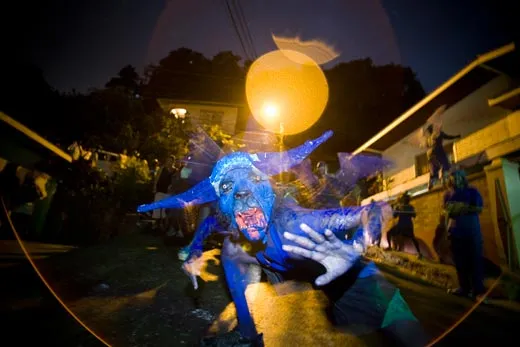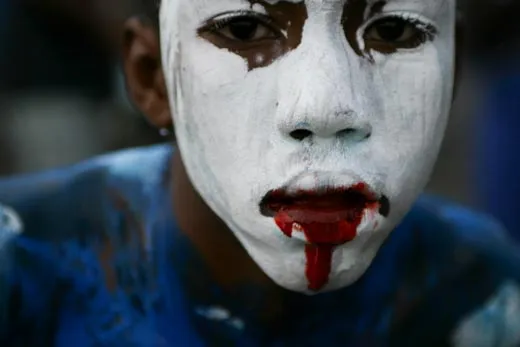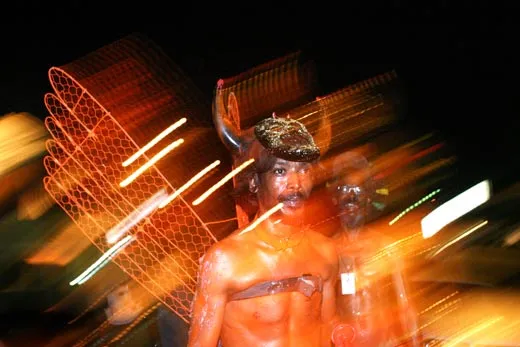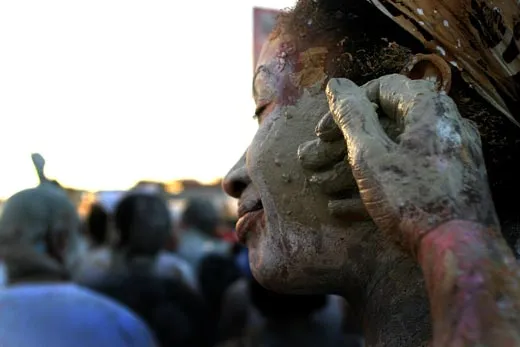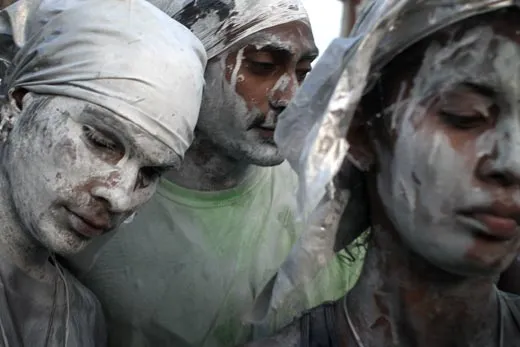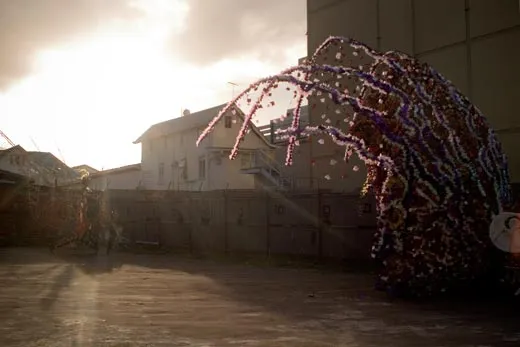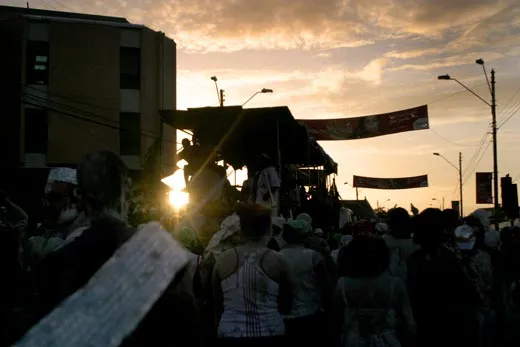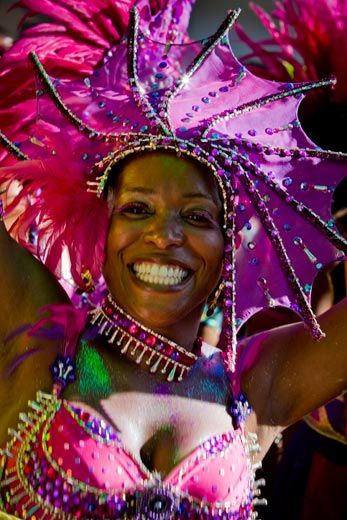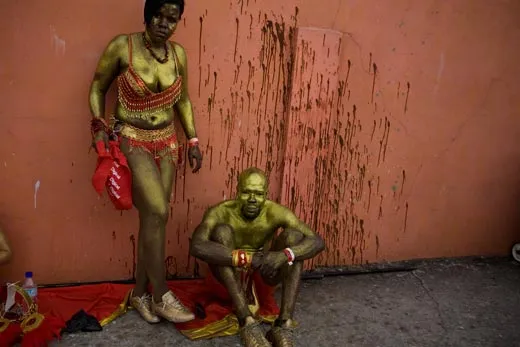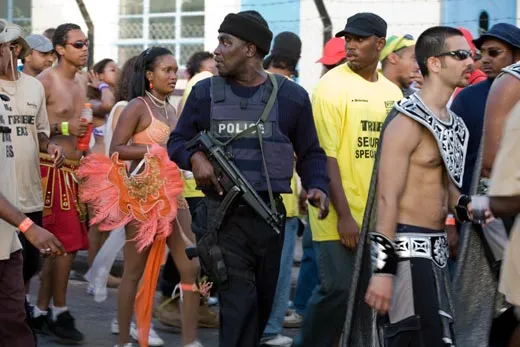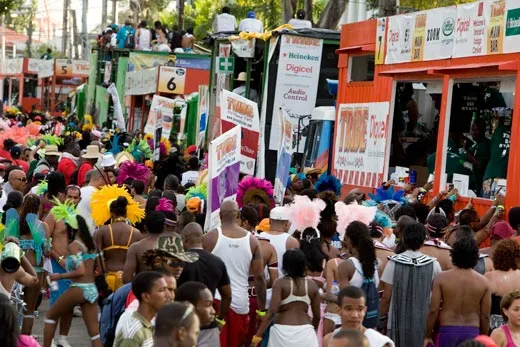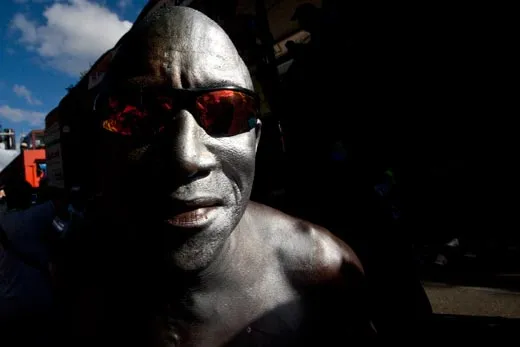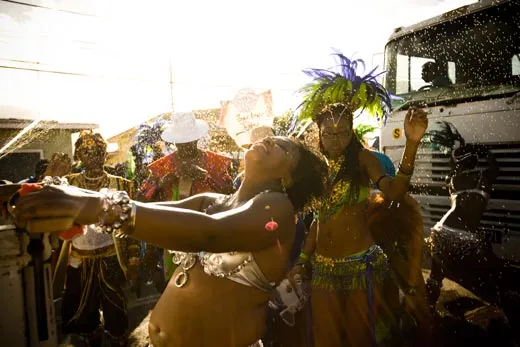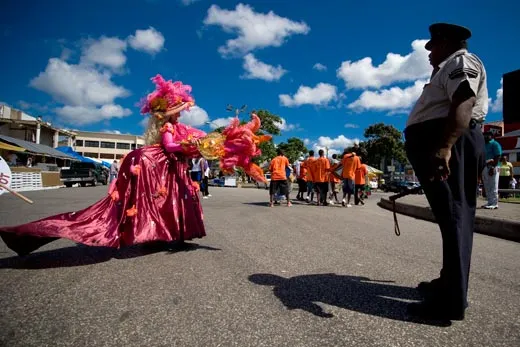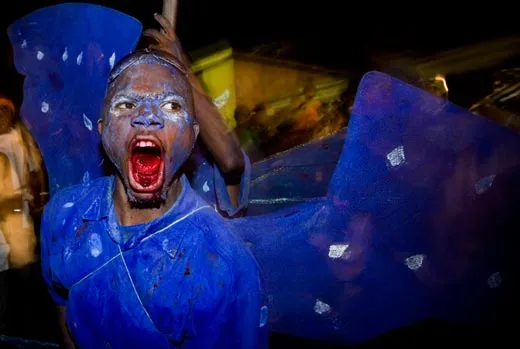Up Close at Trinidad’s Carnival
What’s behind the raucous pre-Lenten rite? An intrepid scholar hits the streets of Trinidad to find out
/https://tf-cmsv2-smithsonianmag-media.s3.amazonaws.com/filer/Paramin-blue-devils-Carnival-631.jpg)
When Northerners think of the Caribbean, Trinidad isn't usually the first place that comes to mind. Until recently, Trinidad had few tourist-oriented hotels or restaurants, and its crime rate is so high that visitors are advised not to venture outdoors wearing watches or jewelry, and definitely not at night. What Trinidad does have is carnival—a centuries-old blowout reputedly so wild and intense that it makes Mardi Gras look like a Veterans' Day parade.
I had a reason beyond hedonism for making the trip. I'd spent nine years researching a book on the carnival tradition, Dancing in the Streets: A History of Collective Joy. Prehistoric rock drawings suggest that costuming and group dancing date back to the Paleolithic. In the 19th century, Western explorers found it going strong among indigenous peoples worldwide, including Polynesians, Inuits, West Africans, Australian Aborigines and villagers in India. In Europe, however, it had been suppressed when Protestantism and the Counter-Reformation wiped out most public festivities, which, over the years, had become flash points for popular unrest.
The European experience in Trinidad is a case in point: 18th-century French settlers brought the tradition of a pre-Lenten festival, in which they found it amusing to dress up and dance like their African slaves. The slaves found it even more amusing to use the confusion of carnival as an occasion for uprisings. Long after the slaves were emancipated by the British in 1838, the colonial administration continued to fight the now-Africanized carnival piece by piece—banning, at one time or another, drums, masks and dancing in the streets.
But carnival survived, and my question was: What compromises had it made to do so? I had watched Key West's version of carnival—October's Fantasy Fest—go downhill over the years, blanched by commercialization and robbed of artistry as the point of it became to bare one's (painted) breasts and drink oneself sick. Had Trinidad managed to keep carnival's traditional creativity and political charge alive? Most of my years of research had been sedentary, in hushed libraries and poorly lit archives. Last February I decided to go dancing in the streets myself.
I arrived in Port of Spain two days before the official start of carnival, giving me plenty of time to see that "mas," as the Trinidadians call it (from "masquerade"), isn't just a diversion. It's practically a national mobilization. Tens of thousands of people poured into the squat, mountain-ringed city, most of them native-born "Trinis" home from other parts of the world, with a few European tourists thrown in. Banners flying over downtown streets advised, for safety's sake, to "stay with your lime," your lime being the friends you came with. Newspapers offered front-page reports of bitter rivalries in the pre-carnival soca music competitions, screaming headlines like " 'No One Will Spoil Dis Mas,' Warns Police Commissioner Paul" and earnest editorials on exactly the kind of questions that concerned me, such as whether the predominance of foreign-made bikini costumes has reduced carnival to a girlie show.
The festivities begin at 4 a.m. on the Monday before Ash Wednesday with a ritual called Jouvay, from either the French jour ouvert ("opening day") or the Creole jou ouvé? ("Is it daybreak yet?"). I had no idea of what I was getting into when I "registered" at the 3canal storefront center the day before. 3canal is both a musical band and one of the many small production companies that stage carnival; the name, according to one of the musicians, Roger Roberts, derives from a type of machete used by cane cutters and, he says, is "a metaphor for cutting and clearing a path and space for vibes to flow and grow." Despite assurances that no one really has to pay, I'd plunked down 60 Trinidadian dollars (about $10 U.S.) for a bag containing a 3canal badge, a white tank top, a square of silver lamé cloth and—ominously—a plastic water bottle filled with white paint.
A little after 4 a.m, I returned to the 3canal storefront with my little lime of four—two Trinis and two other Americans—to find hundreds of people milling around a flatbed truck from which the 3canal musicians were blasting the band's heavy beat into the darkness. Around Port of Spain, people were assembling into 14 other Jouvay bands, each several hundred to a thousand strong, and each with its own music and colors.
When the flatbed truck started rolling, the crowd danced along behind it or, more precisely, "chipped," which is Trinidadian for moving individually to music. At first I chipped in my resolute white-lady way, conscious of my status as the only visible blue-eyed person in the crowd. But then the paint came into play, hurled from bottles and dabbed on any body at hand. A plastic bottle of rough whiskey was passed around. There was a moment of near-panic when a police car forced its way through the crowd, and I learned later that in the pushing and shoving a knife fight had broken out just behind us. But still, the vibe here was overwhelmingly sweet. A teenager planted himself in front of me and announced that I looked "too nice," a condition he corrected by gently anointing my face with fresh paint. I don't know the origins of this orgy of body-painting, and I am glad I hadn't joined one of the Jouvay bands that use chocolate or mud instead, but I know its effect: race was dissolved; even age and gender became theoretical concepts.
In the tradition of Western sociology, crowds are dangerous because they can turn into mobs. So when a contingent from our procession broke away to chase a group of Chinese men watching from the sidelines, I ran along anxiously behind them. Was there resentment of these workers, imported to build downtown skyscrapers? No. Would there be violence? No, the Jouvay celebrants just wanted to cover the foreigners in paint, and the Chinese were doubling over with laughter as they escaped. This was the true and ancient spirit of carnival: there can be no spectators, only participants, and everyone must be anointed.
Sunrise found us in a small public square, and in a condition far from the one we'd started in. We'd been moving through the streets for over three hours, powered by beers passed from hand to hand, and even my ultra-buff American friend was beginning to sag. People were still chipping away, raising their heads toward the already-hot blue sky in a kind of triumph. Hardly anyone was noticeably drunk, but we were annihilated, as individuals anyway—footsore, bone-tired, dripping with paint and sweat. We were, in some transcendent way, perfected.
But carnival has many faces and many moods, with different towns observing it in their own special ways. At dusk we were in the tiny mountain town of Paramin, sitting at an outdoor fried-chicken place. The townspeople were slowly assembling on the edge of the road, drinking beer and chipping to a sound system that had been erected just behind our table. At nightfall, the sound system fell silent, and ten men beating drums made out of biscuit tins emerged from the darkness—a reminder of the Trinidadian ingenuity at drawing music out of industrial detritus, like the island's steel drums, traditionally crafted from oil barrels. Behind the drummers came 20 people of indeterminate age and gender, covered in blue paint, some wearing grotesque devil masks, others leering hideously, leaping and writhing. Then another band of drummers, followed by another contingent from hell.
Some of the devils were pulling others on ropes or mock-beating them with sticks in what is thought to be an evocation of the work-'em-till-they-die slavery of early Trinidad. Certainly, there was an edge of menace here. When a Blue Devil approached and stabbed his finger at you, you had to give him a Trinidadian dollar (worth 16 U.S. cents), or he would pull you up against his freshly painted body. The onlookers laughed and shrieked and ran, and in the end I didn't run fast enough. Having used up my dollars, partly in defense of two genuinely frightened little girls, I was slimed blue. As the devils eased up on their attacks, the crowd swelled and surged toward the town's central square, where vendors were selling beer and rum amid the ongoing chipping. But I was too sticky with paint to continue—and too shaken, I have to admit, by the mimed hostility of the devils, with its echoes of historical rage.
Shrove Tuesday, the second day, is when the mas bands parade through Port of Spain to be judged on their costumes and music. If there was a time to witness the corrupting effects of commercialism, this "pretty mas"—so called to distinguish it from the first day's "old mas"—would be it. There are about 200 mas bands on the island, and each was offering, for the equivalent of several hundred U.S. dollars, a costume and such essentials as a day's worth of food and drink and private security. A pre-carnival article in the Sunday Express estimated that the big bands, with 3,500 or more members, would each gross ten million Trinidadian dollars, not counting donations from corporate sponsors, such as the ubiquitous cellphone company bmobile. This isn't just partying; this is business.
According to historian (and soca star) Hollis Liverpool, pretty mas grew out of the upper classes' efforts to tamp down the African-derived aspects of traditional mas, which they saw as vulgar and unruly. To an extent, they have succeeded: the price of admission limits participation to the more affluent, such as Nadia John, a 30-year-old lawyer I met in her apartment on the Sunday before carnival. For John, it was all about the costume. She modeled the one she would wear with the Island People mas band: a bikini made of wire, feathers and jewels, so minimal that she dared not let her mother see it.
Not that the poor don't try to crash the party—hence the need for all the private security that surrounds each band as it moves through the streets. According to Wyatt Gallery, one of the owners of the Island People band, this is because "we're very serious about the competition and don't want to look bad," as they might if a lot of un-costumed people slipped in.
So I wasn't expecting much, beyond a chance to see Nadia John in her glory, when we walked from our hotel to the part of town where the mas bands would march and found a place on the curb to sit. But it turned out that even pretty mas is impossible to tame. Despite all the "owners" and "producers," people were still creating carnival themselves, in the streets and on the sidelines—chipping, drinking, eating and smoking ganja. Then the bands began to drift by, each with its own trucks for music, food and drink. The marchers were chatting, chipping and, most notably, "wining." This is like grinding in American dance culture, only the pelvic motions are quicker, more fluttery—an artistic rendition of sex rather than a simulation—and it can involve up to three people at a time. Probably not quite what the British meant by "pretty." One costumed woman sticks in my mind, lost in her own chip, throwing her head back, her face gleaming with exultation and sweat. As Goethe wrote of the 18th-century Roman carnival, it "is a festival that is not actually given to the people, but which the people give to themselves."
Yes, Trinidadian carnival has been commercialized—or "Brazilianized," as they say locally—with too much money and booty involved. But as Che Lovelace, a young artist told me, carnival "can't go back, it must go forward." The money helps support hundreds of Trinidadian artists, musicians and entrepreneurs, and, he says, "helps drive the economy and create jobs." In Trinidad, commercialization is not the death of carnival, but part of how it perpetuates itself.
Score card for carnival 2008: in a win for Trinidad's persistent devils, a preliminary body count came to 5 dead and 20 others stabbed or shot. But in a triumph for artistry and social relevance, the title of best mas band went to the MacFarlane band with the apocalyptic theme "Earth: Cries of Despair, Wings of Hope." Its call for planetwide renewal and its towering, avant-garde costumes—giant structures pulled by the wearer and wreathed in colored smoke—stole the show.
Barbara Ehrenreich has written more than 15 books.
Photographer Alex Smailes' book Trinidad and Tobago appeared in 2006.
